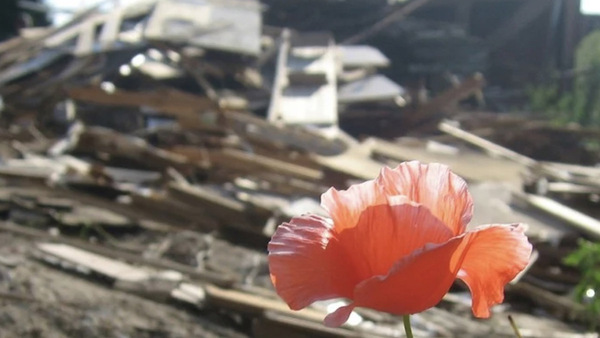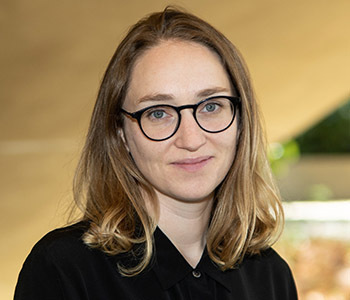

Aidan Seale-Feldman knows a thing or two about what it’s like to witness a disaster. She was working in Nepal in 2015 when a 7.8-magnitude earthquake struck the central region of the country, followed by a 7.3-magnitude aftershock, both of which claimed the lives of more than 9,000 people in total once the ground had ceased heaving and the dust had finally settled. The event changed her life — and her work — forever.
Disasters, both natural and humanitarian, are all around us. How we as humans process tragedy and survive all that suffering — and find ways to continue moving forward — is worth studying.
For Seale-Feldman, an assistant professor and a medical and psychological anthropologist in the Department of Anthropology at the University of Notre Dame, providing the right kind of care for victims of disaster is crucial. She finds insight by studying the diverse ways humans respond to catastrophe and loss, and how those responses are shaped by cultural, social and political factors. Understanding those differences reveals not only why we react the way we do when something awful happens, but also informs how to genuinely and compassionately help those in the middle of a crisis, whatever it may be and wherever they may be.
Our ability to cope with disaster depends on our well-being, resources
When a disaster strikes, Seale-Feldman says, an immediate disorientation can develop in multiple directions — the severity and manifestation of which depends on a person’s well-being and level of social support prior to the disaster, as well as one’s personal and cultural resources in the management of that loss.
“It is certain that those who are in precarious situations, or who were already struggling with feelings of hopelessness, sadness, excessive worry or substance use prior to a disaster, will be more vulnerable to increased distress,” Seale-Feldman explained.
Knowing someone’s history and ability to cope with tragedy sets the stage for what mental health resources they may need.
‘The world is like this’: How different cultures, belief systems deal with disaster
It is important to remember that people from different cultures and belief backgrounds respond to loss differently after a disaster, Seale-Feldman said. She offered the example of the earthquake in Nepal, where she had been working on research on the translation of affliction between Indigenous and psychiatric worlds when the quake hit. The 2015 event helped her to discover that not all cultures see disaster in the same way. In Nepal, a place shaped by Hindu and Buddhist values, many people spoke of suffering as simply the reality of the world we live in.
“They would tell me, ‘The world is like this,’” Seale-Feldman said. “Basically, that life is a constant oscillation between suffering and contentment, misery and joy — everything is impermanent.”
These different human responses to moments of tragedy may also require different approaches to healing. “Not all psychosocial counseling or humanitarian efforts fit every culture or person in the wake of a disaster,” Seale-Feldman said.
For example, there is an idea in Western medicine that talking about loss and expressing negative emotions is necessary for healing. In Nepal, however, “there is a sense that to talk about those who died a bad death (in an accident or before one’s time) can strengthen the attachments between the living and the dead, making it harder for the dead to achieve either rebirth into the next life or liberation from the world,” Seale-Feldman said.
Something she learned from her experience in Nepal was that trained counselors have to find new ways to help those working with loss — in particular, learning healing techniques that may be different from what they have been taught as common practice in their field.
Two ways to offer care emerge
Seale-Feldman refers to the words of Dean Spade, a professor at the Seattle University School of Law, in his book “Mutual Aid: Building Solidarity During This Crisis (and the Next),” where he argues that there are two main forms of care that emerge in the wake of a disaster: charity and mutual aid.
“Humanitarianism, a form of charity, relies on a hierarchical model in which those with resources decide who is deserving of aid and in what form, while mutual aid involves a nonhierarchical effort of collective coordination to meet each other’s needs,” Seale-Feldman explained.
One of the major issues in humanitarianism is that care is allocated based on “victim status,” Seale-Feldman said, “such that anyone who is not eligible as a victim based on predetermined criteria will be excluded from receiving aid, even if they may be suffering due to other issues.”
Mutual aid, however, offers a different form of care that sees all those involved as eligible sufferers in need of equal and adequate attention.
According to Seale-Feldman, beyond these two models, there are also smaller forms of care that emerge in the aftermath that are important to acknowledge and focus on, such as “the risks undertaken by some to help others, acts of kindness and generosity, and interactions marked by gentleness between people.”
These modes of assistance are what Seale-Feldman strives to illuminate in her own work.
How can we help better, for longer?
Seale-Feldman said that sustainability is one of the biggest problems with humanitarian efforts in terms of bringing access to mental health and psychosocial counseling to countries where mental health had not been incorporated into the public health care system.
“One thing I think humanitarians must ask is, ‘What are the ethics of giving care post-disaster, only to take it away once the disaster has been deemed over and all immediate effects have subsided?’ These finite programs make us think to ourselves, ‘What happens after that?’”
One response to this issue of sustainability has been an increasing effort to actually construct more permanent and inclusive mental health systems in times of emergency.
Is it possible to mentally and socially prepare for a disaster?
Regardless of where a disaster takes place in the world, there are some questions to be asked and lessons to be learned. “Disasters call on us to question the current state of affairs, to ask how it is that such a thing has happened and to critically rethink how we should be living — both in relation to each other and on a rapidly changing planet,” Seale-Feldman pointed out. “Disasters often provide a momentary opening for certain things to change.
“At a very immediate level, social support always plays a crucial role in the aftermath of a disaster. If we have strong social support networks in place, this will be very beneficial and protective — and not only in times of crisis.”
In part, this may mean building up mental health support services into current public health care systems — and being mindful of what those will look like, culturally and socially, depending on the community they are serving.
“The question is, how can we sustain this concern for others and these forms of community in life beyond the disaster?” Seale-Feldman asked.
“I think one thing we can do is to actively remember the relationships that are made possible because of the disaster — as well as the acts of care, kindness and solidarity that arise in its wake — with the hope that they might become blueprints for new ways of being and relating to others in the future.”
Contact: Tracy DeStazio, associate director of media relations, 574-631-9958 or tdestazi@nd.edu
Originally published by at news.nd.edu on December 19, 2023.